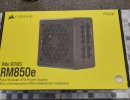Let me start off by saying I am not computer savvy.
I purchased a desktop gaming rig online a few years ago, and choose some high end parts as I wanted to be able to play the newer games. The computer ran perfectly, until one day when I went to turn it on. There was a loud click, and then nothing. She was dead. After doing some searching, it seems my power unit fried. I also discovered that the breaker in my panel box had popped. I'm not sure if a surge came FROM the computer out and popped the breaker, or if a surge came IN, got past the breaker and fried the power unit while popping the breaker at the same time, or what. I recently discovered that the outlet where I had my tower, monitor, gaming table, and speakers plugged in ALSO carry lines from our washing machine and a few other things (thanks, Dad).
I haven't yet replaced the power unit as I'm nervous to do so, and my bedroom was being overhauled so it's been sitting under some tarp for now. But my question is, can I run my tower through an extension cord to a nearby outlet that only has a lamp running on it? I'm assuming I'd need a cord and power bar rated for the power of the unit. I'm thinking separating the tower from the rest of the equipment (monitor, etc) to allow the full circuit to carry only the tower.
Advice greatly appreciated.
Build details as follows:
I purchased a desktop gaming rig online a few years ago, and choose some high end parts as I wanted to be able to play the newer games. The computer ran perfectly, until one day when I went to turn it on. There was a loud click, and then nothing. She was dead. After doing some searching, it seems my power unit fried. I also discovered that the breaker in my panel box had popped. I'm not sure if a surge came FROM the computer out and popped the breaker, or if a surge came IN, got past the breaker and fried the power unit while popping the breaker at the same time, or what. I recently discovered that the outlet where I had my tower, monitor, gaming table, and speakers plugged in ALSO carry lines from our washing machine and a few other things (thanks, Dad).
I haven't yet replaced the power unit as I'm nervous to do so, and my bedroom was being overhauled so it's been sitting under some tarp for now. But my question is, can I run my tower through an extension cord to a nearby outlet that only has a lamp running on it? I'm assuming I'd need a cord and power bar rated for the power of the unit. I'm thinking separating the tower from the rest of the equipment (monitor, etc) to allow the full circuit to carry only the tower.
Advice greatly appreciated.
Build details as follows:
| Case | iBUYPOWER Trace 5 MR Tempered Glass ARGB Gaming Case- |
| Case Fans | 3x [ARGB] be quiet! Light Wings 120mm Black PWM Fan Pack- |
| Processor | AMD Ryzen™ 9 7950X Processor (16X 4.5GHz/64MB L3 Cache)- |
| Processor Cooling | iBUYPOWER 240mm Addressable RGB Liquid Cooler - Black-Free Upgrade to iBUYPOWER 360mm Addressable RGB Liquid Cooler - Black |
| Memory | 64 GB [32 GB X2] DDR5-5600MHz Memory Module-Certified Major Brand Gaming Memory |
| Video Card | NVIDIA GeForce RTX 4080 - 16GB GDDR6X (DLSS 3.0 – AI-Powered Performance)- |
| Motherboard | MSI PRO X670-P WIFI - Wifi 6E, ARGB Header (2), USB 3.2 Ports (1 Type-C, 6 Type-A), M.2 Slot (3)- |
| Power Supply | 850 Watt - High Power -80 PLUS Gold Certified PCIe GEN 5- |
| Primary Storage | 2TB Samsung 970 EVO PLUS M.2 PCIe NVMe SSD -- Read: 3500MB/s; Write: 3300MB/s- |
| Secondary Storage | 4TB WD BLUE HARD DRIVE - 5400RPM |
| Media Card Reader / Writer | None- |
| Sound Card | 3D Premium Surround Sound Onboard- |
| Game Controller | None- |
| Operating System | Windows 11 Home w/ Windows Recovery USB-(64-bit) |


